Transition Theory: A Comparative Analysis of Transitions in Singapore
VerifiedAdded on 2021/05/27
|10
|2868
|115
Essay
AI Summary
This essay analyzes transition theory within the specific context of Singapore, examining both childhood and adult transitions. It begins by establishing Singapore's societal perspective on children and their significance to the economy. The essay then independently explores adult and childhood transitions, providing examples relevant to the Singaporean experience. Key psychological theories, including self-efficacy and self-determination theory, are discussed in relation to these transitions, with the constructivist model used to explain how children assimilate into their environment. The paper also considers socio-ecological models and Erikson's stages of development to provide a comprehensive understanding of the challenges and opportunities inherent in these crucial life stages. The essay concludes with the implications of these transitions for individuals and the society as a whole.
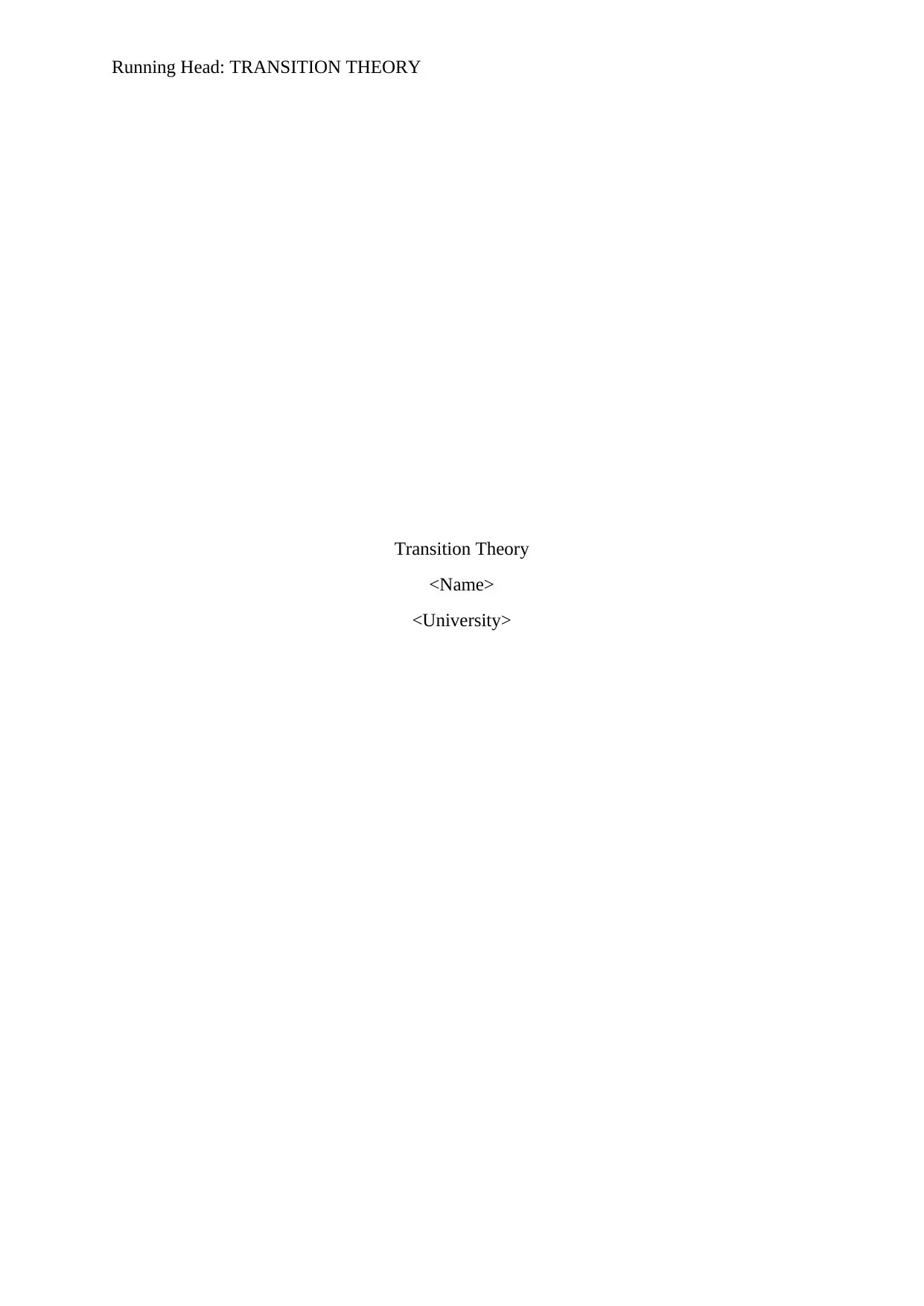
Running Head: TRANSITION THEORY
Transition Theory
<Name>
<University>
Transition Theory
<Name>
<University>
Paraphrase This Document
Need a fresh take? Get an instant paraphrase of this document with our AI Paraphraser
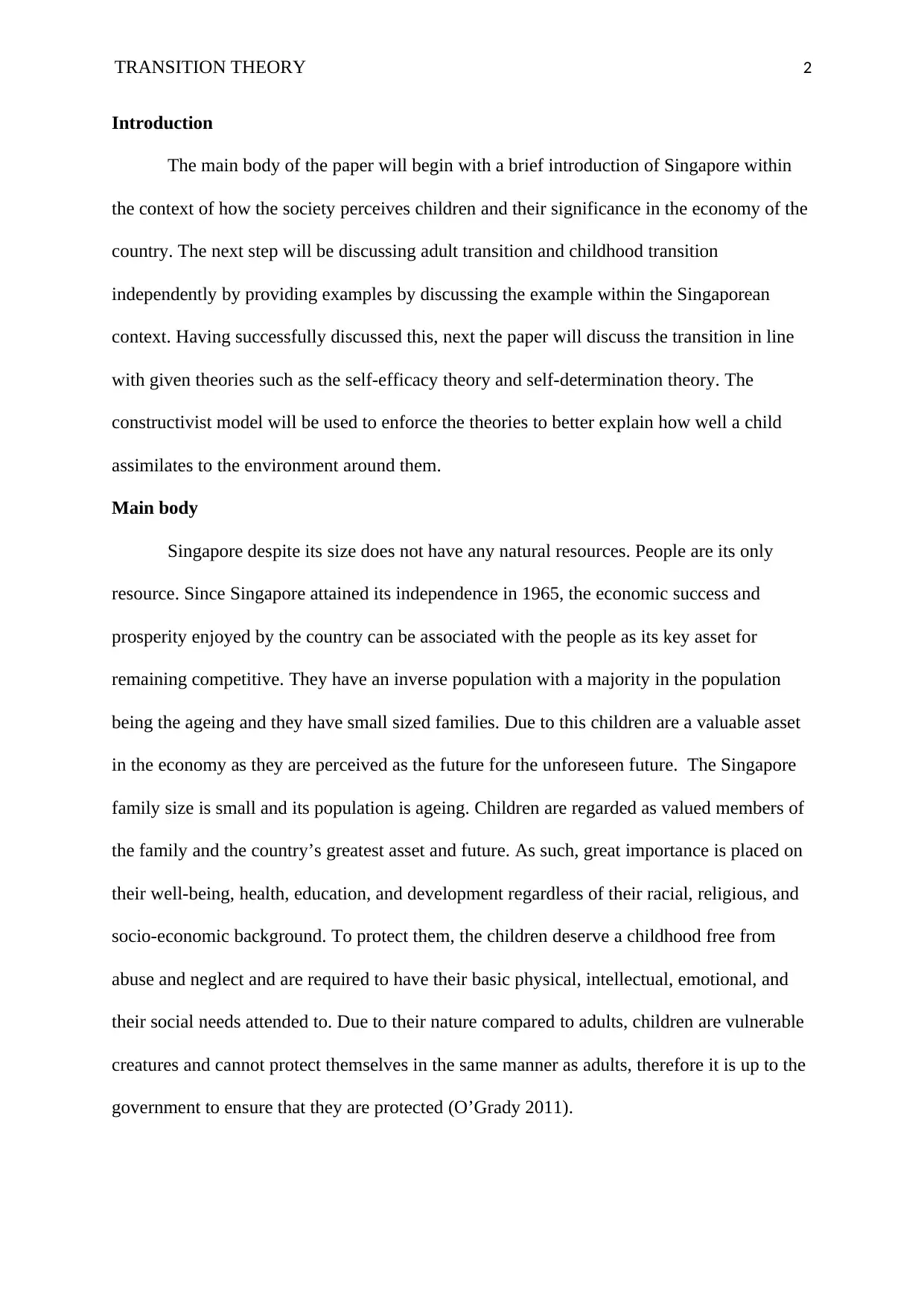
TRANSITION THEORY 2
Introduction
The main body of the paper will begin with a brief introduction of Singapore within
the context of how the society perceives children and their significance in the economy of the
country. The next step will be discussing adult transition and childhood transition
independently by providing examples by discussing the example within the Singaporean
context. Having successfully discussed this, next the paper will discuss the transition in line
with given theories such as the self-efficacy theory and self-determination theory. The
constructivist model will be used to enforce the theories to better explain how well a child
assimilates to the environment around them.
Main body
Singapore despite its size does not have any natural resources. People are its only
resource. Since Singapore attained its independence in 1965, the economic success and
prosperity enjoyed by the country can be associated with the people as its key asset for
remaining competitive. They have an inverse population with a majority in the population
being the ageing and they have small sized families. Due to this children are a valuable asset
in the economy as they are perceived as the future for the unforeseen future. The Singapore
family size is small and its population is ageing. Children are regarded as valued members of
the family and the country’s greatest asset and future. As such, great importance is placed on
their well-being, health, education, and development regardless of their racial, religious, and
socio-economic background. To protect them, the children deserve a childhood free from
abuse and neglect and are required to have their basic physical, intellectual, emotional, and
their social needs attended to. Due to their nature compared to adults, children are vulnerable
creatures and cannot protect themselves in the same manner as adults, therefore it is up to the
government to ensure that they are protected (O’Grady 2011).
Introduction
The main body of the paper will begin with a brief introduction of Singapore within
the context of how the society perceives children and their significance in the economy of the
country. The next step will be discussing adult transition and childhood transition
independently by providing examples by discussing the example within the Singaporean
context. Having successfully discussed this, next the paper will discuss the transition in line
with given theories such as the self-efficacy theory and self-determination theory. The
constructivist model will be used to enforce the theories to better explain how well a child
assimilates to the environment around them.
Main body
Singapore despite its size does not have any natural resources. People are its only
resource. Since Singapore attained its independence in 1965, the economic success and
prosperity enjoyed by the country can be associated with the people as its key asset for
remaining competitive. They have an inverse population with a majority in the population
being the ageing and they have small sized families. Due to this children are a valuable asset
in the economy as they are perceived as the future for the unforeseen future. The Singapore
family size is small and its population is ageing. Children are regarded as valued members of
the family and the country’s greatest asset and future. As such, great importance is placed on
their well-being, health, education, and development regardless of their racial, religious, and
socio-economic background. To protect them, the children deserve a childhood free from
abuse and neglect and are required to have their basic physical, intellectual, emotional, and
their social needs attended to. Due to their nature compared to adults, children are vulnerable
creatures and cannot protect themselves in the same manner as adults, therefore it is up to the
government to ensure that they are protected (O’Grady 2011).
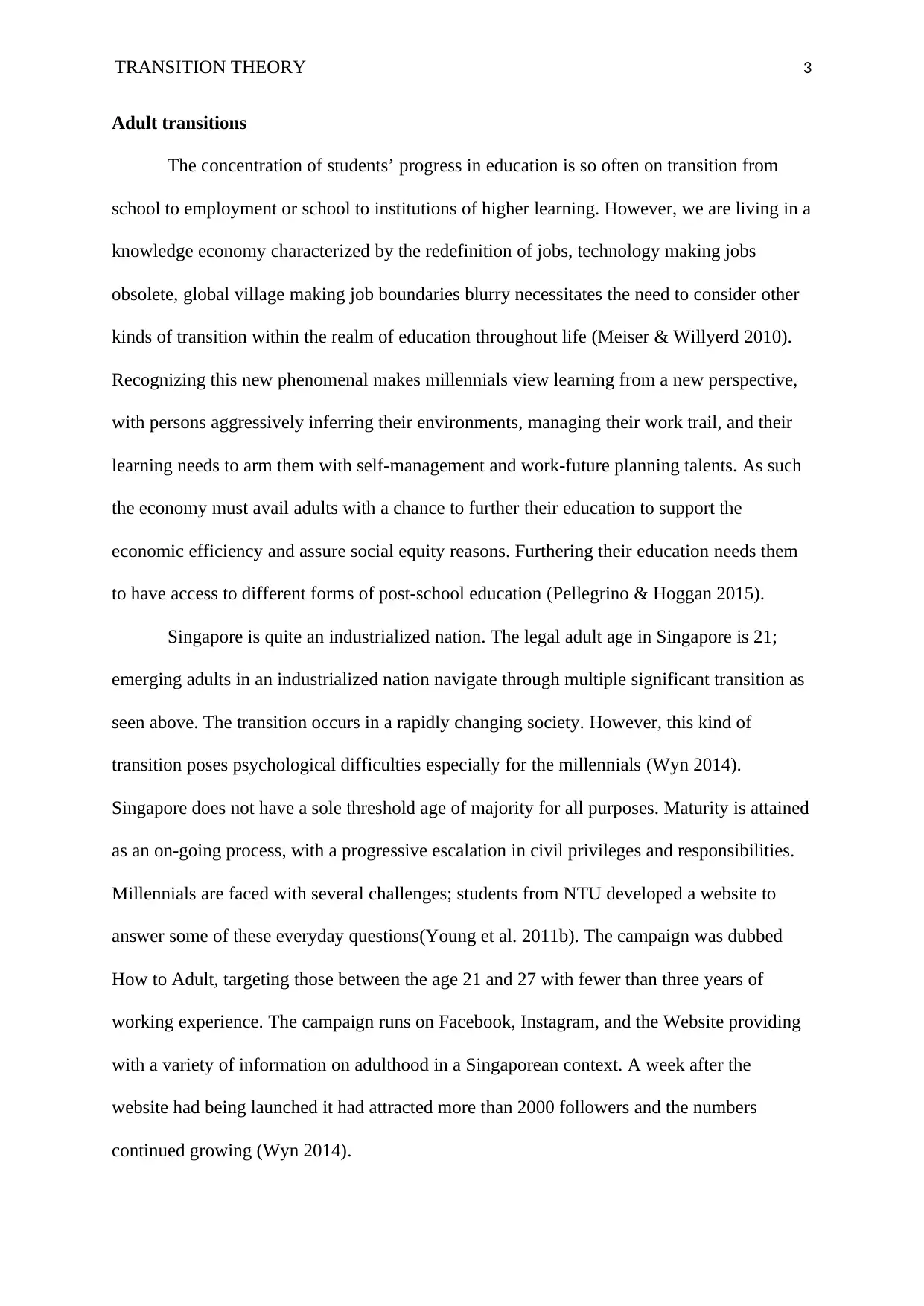
TRANSITION THEORY 3
Adult transitions
The concentration of students’ progress in education is so often on transition from
school to employment or school to institutions of higher learning. However, we are living in a
knowledge economy characterized by the redefinition of jobs, technology making jobs
obsolete, global village making job boundaries blurry necessitates the need to consider other
kinds of transition within the realm of education throughout life (Meiser & Willyerd 2010).
Recognizing this new phenomenal makes millennials view learning from a new perspective,
with persons aggressively inferring their environments, managing their work trail, and their
learning needs to arm them with self-management and work-future planning talents. As such
the economy must avail adults with a chance to further their education to support the
economic efficiency and assure social equity reasons. Furthering their education needs them
to have access to different forms of post-school education (Pellegrino & Hoggan 2015).
Singapore is quite an industrialized nation. The legal adult age in Singapore is 21;
emerging adults in an industrialized nation navigate through multiple significant transition as
seen above. The transition occurs in a rapidly changing society. However, this kind of
transition poses psychological difficulties especially for the millennials (Wyn 2014).
Singapore does not have a sole threshold age of majority for all purposes. Maturity is attained
as an on-going process, with a progressive escalation in civil privileges and responsibilities.
Millennials are faced with several challenges; students from NTU developed a website to
answer some of these everyday questions(Young et al. 2011b). The campaign was dubbed
How to Adult, targeting those between the age 21 and 27 with fewer than three years of
working experience. The campaign runs on Facebook, Instagram, and the Website providing
with a variety of information on adulthood in a Singaporean context. A week after the
website had being launched it had attracted more than 2000 followers and the numbers
continued growing (Wyn 2014).
Adult transitions
The concentration of students’ progress in education is so often on transition from
school to employment or school to institutions of higher learning. However, we are living in a
knowledge economy characterized by the redefinition of jobs, technology making jobs
obsolete, global village making job boundaries blurry necessitates the need to consider other
kinds of transition within the realm of education throughout life (Meiser & Willyerd 2010).
Recognizing this new phenomenal makes millennials view learning from a new perspective,
with persons aggressively inferring their environments, managing their work trail, and their
learning needs to arm them with self-management and work-future planning talents. As such
the economy must avail adults with a chance to further their education to support the
economic efficiency and assure social equity reasons. Furthering their education needs them
to have access to different forms of post-school education (Pellegrino & Hoggan 2015).
Singapore is quite an industrialized nation. The legal adult age in Singapore is 21;
emerging adults in an industrialized nation navigate through multiple significant transition as
seen above. The transition occurs in a rapidly changing society. However, this kind of
transition poses psychological difficulties especially for the millennials (Wyn 2014).
Singapore does not have a sole threshold age of majority for all purposes. Maturity is attained
as an on-going process, with a progressive escalation in civil privileges and responsibilities.
Millennials are faced with several challenges; students from NTU developed a website to
answer some of these everyday questions(Young et al. 2011b). The campaign was dubbed
How to Adult, targeting those between the age 21 and 27 with fewer than three years of
working experience. The campaign runs on Facebook, Instagram, and the Website providing
with a variety of information on adulthood in a Singaporean context. A week after the
website had being launched it had attracted more than 2000 followers and the numbers
continued growing (Wyn 2014).
⊘ This is a preview!⊘
Do you want full access?
Subscribe today to unlock all pages.

Trusted by 1+ million students worldwide
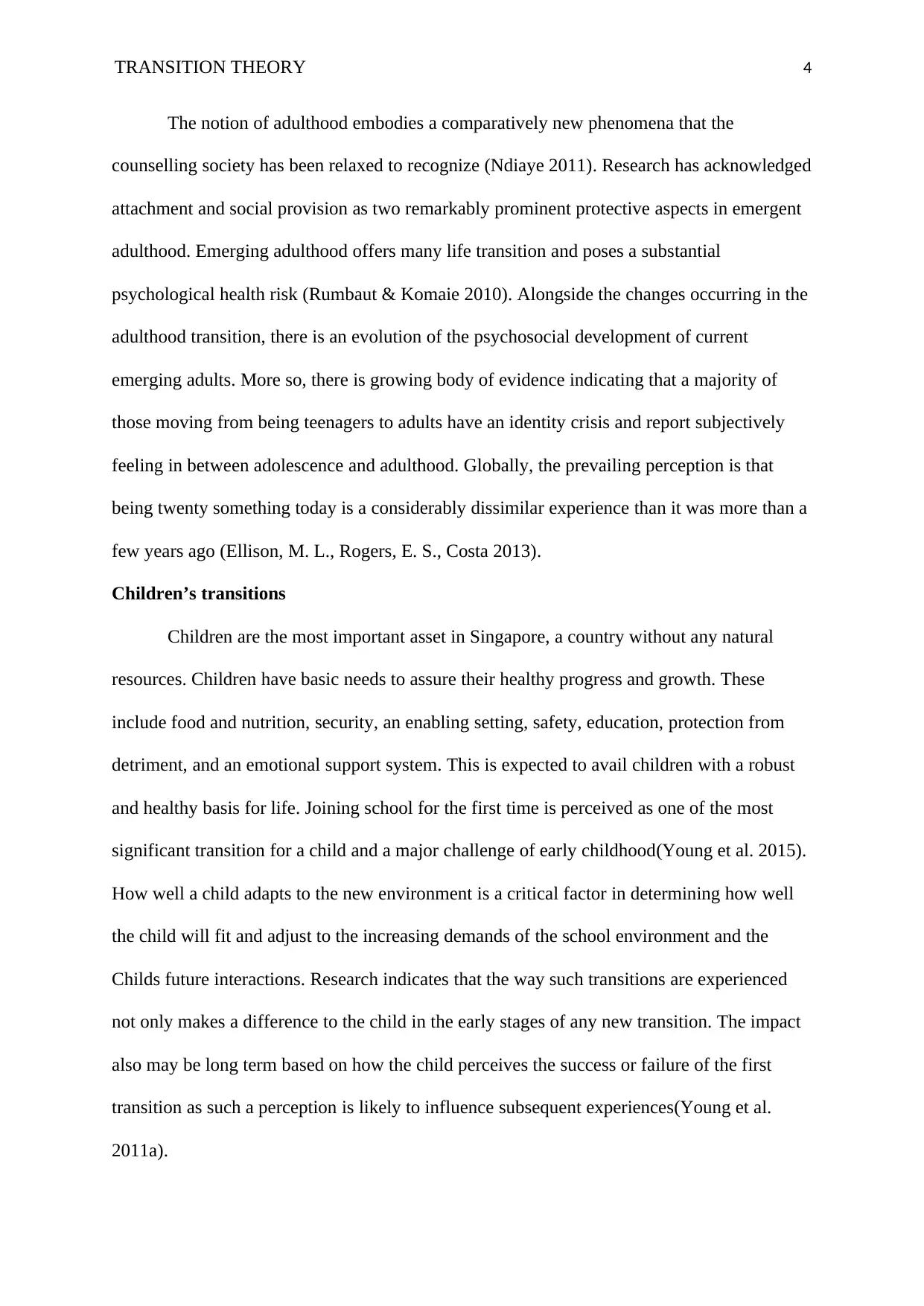
TRANSITION THEORY 4
The notion of adulthood embodies a comparatively new phenomena that the
counselling society has been relaxed to recognize (Ndiaye 2011). Research has acknowledged
attachment and social provision as two remarkably prominent protective aspects in emergent
adulthood. Emerging adulthood offers many life transition and poses a substantial
psychological health risk (Rumbaut & Komaie 2010). Alongside the changes occurring in the
adulthood transition, there is an evolution of the psychosocial development of current
emerging adults. More so, there is growing body of evidence indicating that a majority of
those moving from being teenagers to adults have an identity crisis and report subjectively
feeling in between adolescence and adulthood. Globally, the prevailing perception is that
being twenty something today is a considerably dissimilar experience than it was more than a
few years ago (Ellison, M. L., Rogers, E. S., Costa 2013).
Children’s transitions
Children are the most important asset in Singapore, a country without any natural
resources. Children have basic needs to assure their healthy progress and growth. These
include food and nutrition, security, an enabling setting, safety, education, protection from
detriment, and an emotional support system. This is expected to avail children with a robust
and healthy basis for life. Joining school for the first time is perceived as one of the most
significant transition for a child and a major challenge of early childhood(Young et al. 2015).
How well a child adapts to the new environment is a critical factor in determining how well
the child will fit and adjust to the increasing demands of the school environment and the
Childs future interactions. Research indicates that the way such transitions are experienced
not only makes a difference to the child in the early stages of any new transition. The impact
also may be long term based on how the child perceives the success or failure of the first
transition as such a perception is likely to influence subsequent experiences(Young et al.
2011a).
The notion of adulthood embodies a comparatively new phenomena that the
counselling society has been relaxed to recognize (Ndiaye 2011). Research has acknowledged
attachment and social provision as two remarkably prominent protective aspects in emergent
adulthood. Emerging adulthood offers many life transition and poses a substantial
psychological health risk (Rumbaut & Komaie 2010). Alongside the changes occurring in the
adulthood transition, there is an evolution of the psychosocial development of current
emerging adults. More so, there is growing body of evidence indicating that a majority of
those moving from being teenagers to adults have an identity crisis and report subjectively
feeling in between adolescence and adulthood. Globally, the prevailing perception is that
being twenty something today is a considerably dissimilar experience than it was more than a
few years ago (Ellison, M. L., Rogers, E. S., Costa 2013).
Children’s transitions
Children are the most important asset in Singapore, a country without any natural
resources. Children have basic needs to assure their healthy progress and growth. These
include food and nutrition, security, an enabling setting, safety, education, protection from
detriment, and an emotional support system. This is expected to avail children with a robust
and healthy basis for life. Joining school for the first time is perceived as one of the most
significant transition for a child and a major challenge of early childhood(Young et al. 2015).
How well a child adapts to the new environment is a critical factor in determining how well
the child will fit and adjust to the increasing demands of the school environment and the
Childs future interactions. Research indicates that the way such transitions are experienced
not only makes a difference to the child in the early stages of any new transition. The impact
also may be long term based on how the child perceives the success or failure of the first
transition as such a perception is likely to influence subsequent experiences(Young et al.
2011a).
Paraphrase This Document
Need a fresh take? Get an instant paraphrase of this document with our AI Paraphraser
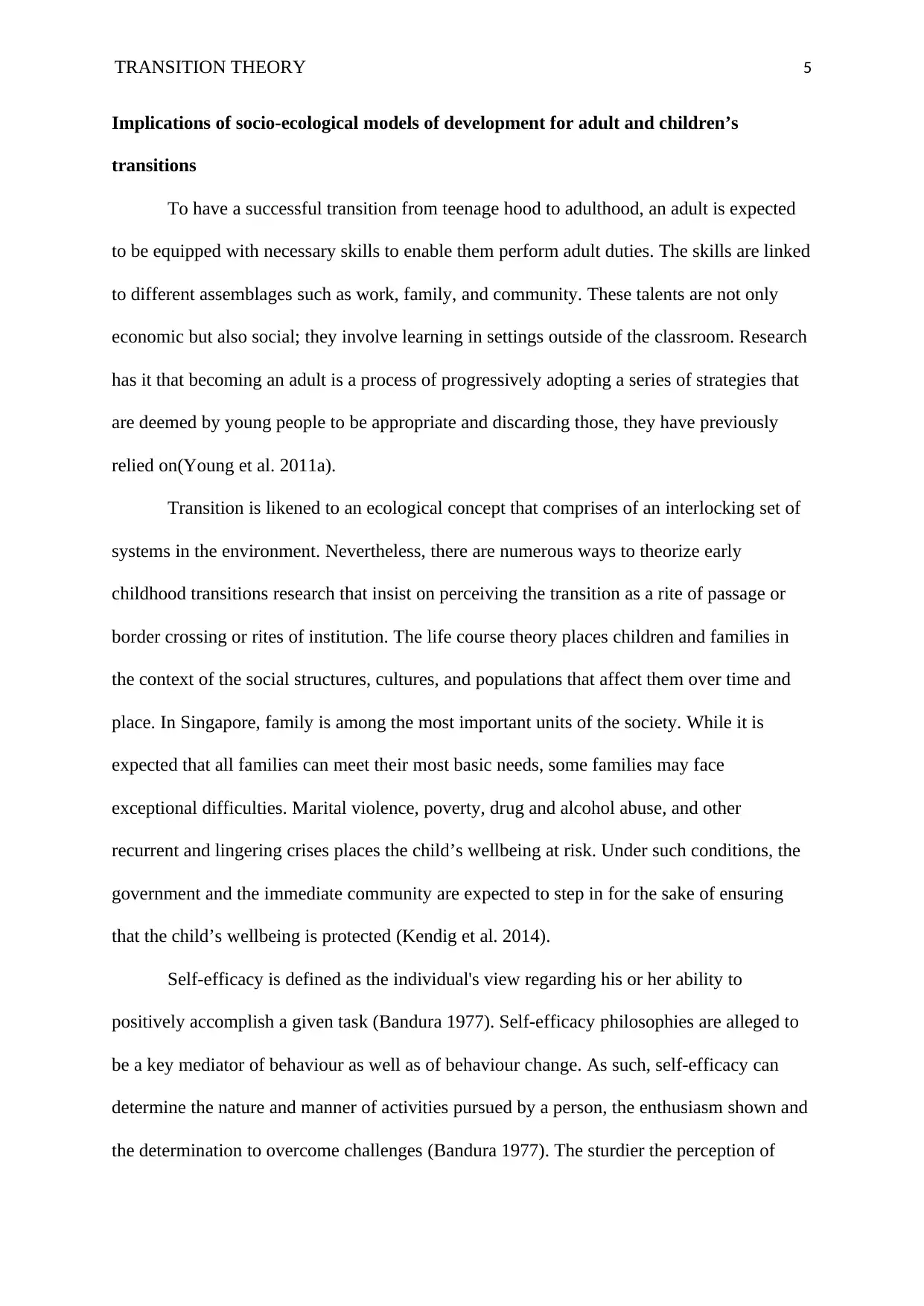
TRANSITION THEORY 5
Implications of socio-ecological models of development for adult and children’s
transitions
To have a successful transition from teenage hood to adulthood, an adult is expected
to be equipped with necessary skills to enable them perform adult duties. The skills are linked
to different assemblages such as work, family, and community. These talents are not only
economic but also social; they involve learning in settings outside of the classroom. Research
has it that becoming an adult is a process of progressively adopting a series of strategies that
are deemed by young people to be appropriate and discarding those, they have previously
relied on(Young et al. 2011a).
Transition is likened to an ecological concept that comprises of an interlocking set of
systems in the environment. Nevertheless, there are numerous ways to theorize early
childhood transitions research that insist on perceiving the transition as a rite of passage or
border crossing or rites of institution. The life course theory places children and families in
the context of the social structures, cultures, and populations that affect them over time and
place. In Singapore, family is among the most important units of the society. While it is
expected that all families can meet their most basic needs, some families may face
exceptional difficulties. Marital violence, poverty, drug and alcohol abuse, and other
recurrent and lingering crises places the child’s wellbeing at risk. Under such conditions, the
government and the immediate community are expected to step in for the sake of ensuring
that the child’s wellbeing is protected (Kendig et al. 2014).
Self-efficacy is defined as the individual's view regarding his or her ability to
positively accomplish a given task (Bandura 1977). Self-efficacy philosophies are alleged to
be a key mediator of behaviour as well as of behaviour change. As such, self-efficacy can
determine the nature and manner of activities pursued by a person, the enthusiasm shown and
the determination to overcome challenges (Bandura 1977). The sturdier the perception of
Implications of socio-ecological models of development for adult and children’s
transitions
To have a successful transition from teenage hood to adulthood, an adult is expected
to be equipped with necessary skills to enable them perform adult duties. The skills are linked
to different assemblages such as work, family, and community. These talents are not only
economic but also social; they involve learning in settings outside of the classroom. Research
has it that becoming an adult is a process of progressively adopting a series of strategies that
are deemed by young people to be appropriate and discarding those, they have previously
relied on(Young et al. 2011a).
Transition is likened to an ecological concept that comprises of an interlocking set of
systems in the environment. Nevertheless, there are numerous ways to theorize early
childhood transitions research that insist on perceiving the transition as a rite of passage or
border crossing or rites of institution. The life course theory places children and families in
the context of the social structures, cultures, and populations that affect them over time and
place. In Singapore, family is among the most important units of the society. While it is
expected that all families can meet their most basic needs, some families may face
exceptional difficulties. Marital violence, poverty, drug and alcohol abuse, and other
recurrent and lingering crises places the child’s wellbeing at risk. Under such conditions, the
government and the immediate community are expected to step in for the sake of ensuring
that the child’s wellbeing is protected (Kendig et al. 2014).
Self-efficacy is defined as the individual's view regarding his or her ability to
positively accomplish a given task (Bandura 1977). Self-efficacy philosophies are alleged to
be a key mediator of behaviour as well as of behaviour change. As such, self-efficacy can
determine the nature and manner of activities pursued by a person, the enthusiasm shown and
the determination to overcome challenges (Bandura 1977). The sturdier the perception of
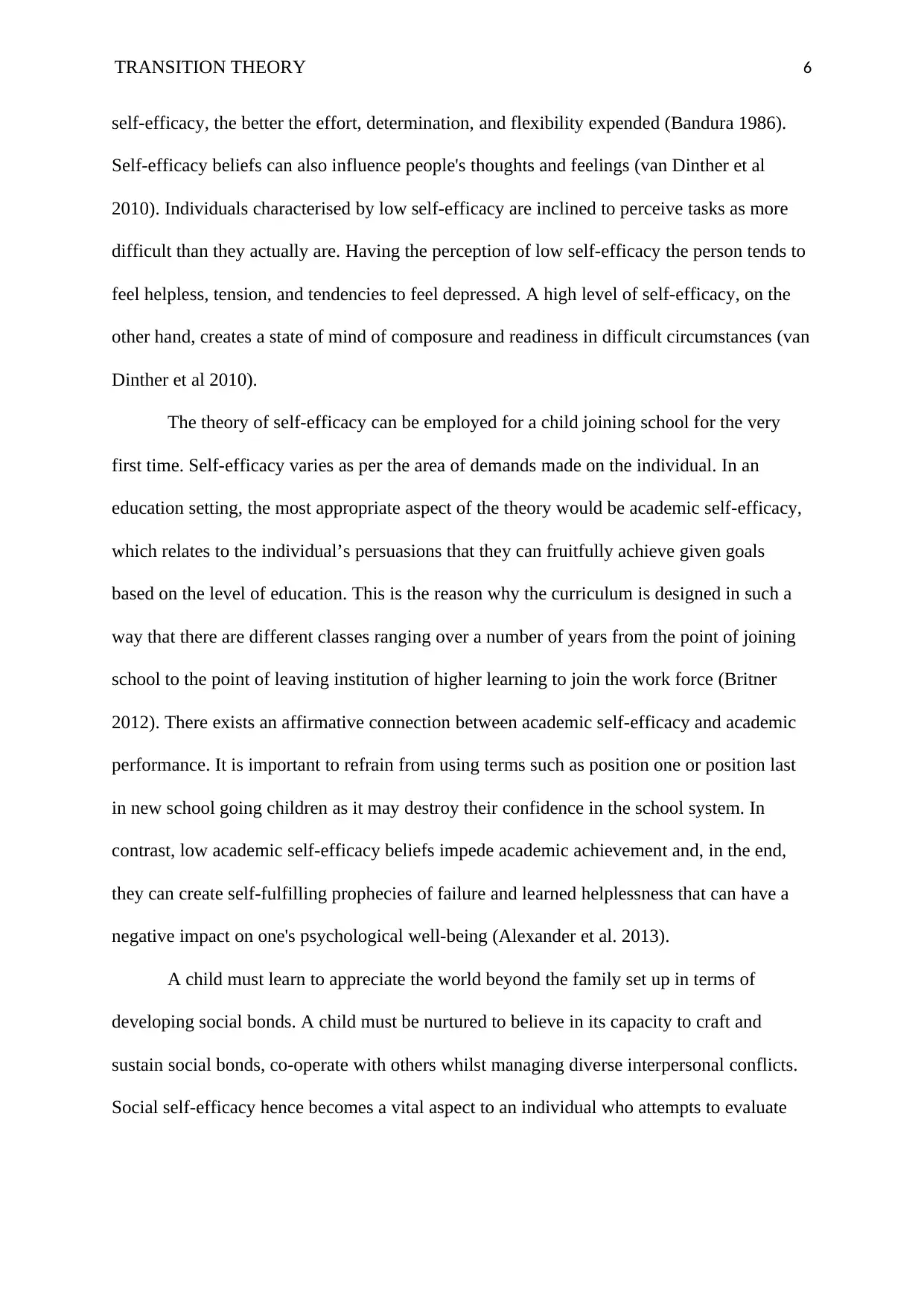
TRANSITION THEORY 6
self-efficacy, the better the effort, determination, and flexibility expended (Bandura 1986).
Self-efficacy beliefs can also influence people's thoughts and feelings (van Dinther et al
2010). Individuals characterised by low self-efficacy are inclined to perceive tasks as more
difficult than they actually are. Having the perception of low self-efficacy the person tends to
feel helpless, tension, and tendencies to feel depressed. A high level of self-efficacy, on the
other hand, creates a state of mind of composure and readiness in difficult circumstances (van
Dinther et al 2010).
The theory of self-efficacy can be employed for a child joining school for the very
first time. Self-efficacy varies as per the area of demands made on the individual. In an
education setting, the most appropriate aspect of the theory would be academic self-efficacy,
which relates to the individual’s persuasions that they can fruitfully achieve given goals
based on the level of education. This is the reason why the curriculum is designed in such a
way that there are different classes ranging over a number of years from the point of joining
school to the point of leaving institution of higher learning to join the work force (Britner
2012). There exists an affirmative connection between academic self-efficacy and academic
performance. It is important to refrain from using terms such as position one or position last
in new school going children as it may destroy their confidence in the school system. In
contrast, low academic self-efficacy beliefs impede academic achievement and, in the end,
they can create self-fulfilling prophecies of failure and learned helplessness that can have a
negative impact on one's psychological well-being (Alexander et al. 2013).
A child must learn to appreciate the world beyond the family set up in terms of
developing social bonds. A child must be nurtured to believe in its capacity to craft and
sustain social bonds, co-operate with others whilst managing diverse interpersonal conflicts.
Social self-efficacy hence becomes a vital aspect to an individual who attempts to evaluate
self-efficacy, the better the effort, determination, and flexibility expended (Bandura 1986).
Self-efficacy beliefs can also influence people's thoughts and feelings (van Dinther et al
2010). Individuals characterised by low self-efficacy are inclined to perceive tasks as more
difficult than they actually are. Having the perception of low self-efficacy the person tends to
feel helpless, tension, and tendencies to feel depressed. A high level of self-efficacy, on the
other hand, creates a state of mind of composure and readiness in difficult circumstances (van
Dinther et al 2010).
The theory of self-efficacy can be employed for a child joining school for the very
first time. Self-efficacy varies as per the area of demands made on the individual. In an
education setting, the most appropriate aspect of the theory would be academic self-efficacy,
which relates to the individual’s persuasions that they can fruitfully achieve given goals
based on the level of education. This is the reason why the curriculum is designed in such a
way that there are different classes ranging over a number of years from the point of joining
school to the point of leaving institution of higher learning to join the work force (Britner
2012). There exists an affirmative connection between academic self-efficacy and academic
performance. It is important to refrain from using terms such as position one or position last
in new school going children as it may destroy their confidence in the school system. In
contrast, low academic self-efficacy beliefs impede academic achievement and, in the end,
they can create self-fulfilling prophecies of failure and learned helplessness that can have a
negative impact on one's psychological well-being (Alexander et al. 2013).
A child must learn to appreciate the world beyond the family set up in terms of
developing social bonds. A child must be nurtured to believe in its capacity to craft and
sustain social bonds, co-operate with others whilst managing diverse interpersonal conflicts.
Social self-efficacy hence becomes a vital aspect to an individual who attempts to evaluate
⊘ This is a preview!⊘
Do you want full access?
Subscribe today to unlock all pages.

Trusted by 1+ million students worldwide
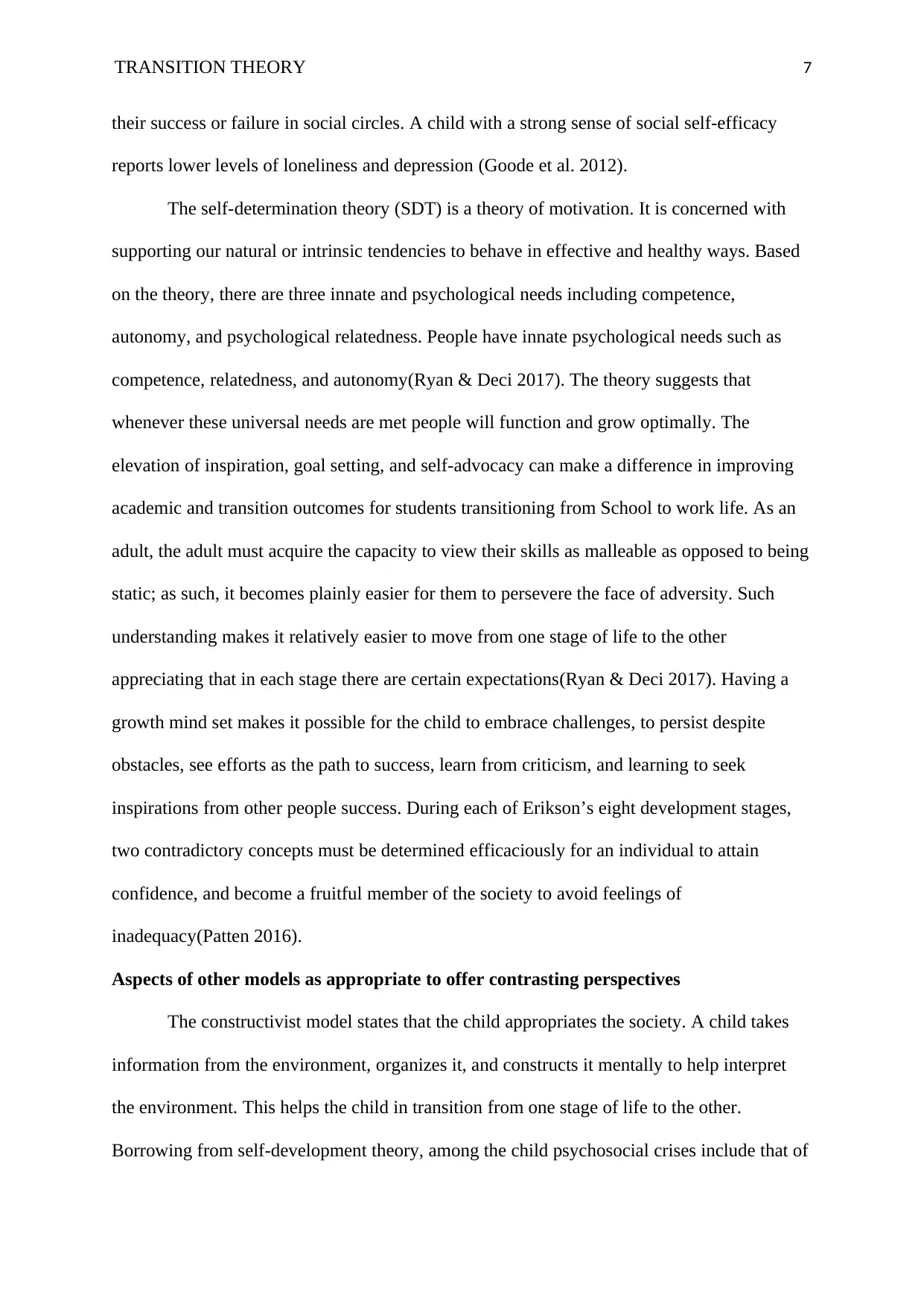
TRANSITION THEORY 7
their success or failure in social circles. A child with a strong sense of social self-efficacy
reports lower levels of loneliness and depression (Goode et al. 2012).
The self-determination theory (SDT) is a theory of motivation. It is concerned with
supporting our natural or intrinsic tendencies to behave in effective and healthy ways. Based
on the theory, there are three innate and psychological needs including competence,
autonomy, and psychological relatedness. People have innate psychological needs such as
competence, relatedness, and autonomy(Ryan & Deci 2017). The theory suggests that
whenever these universal needs are met people will function and grow optimally. The
elevation of inspiration, goal setting, and self-advocacy can make a difference in improving
academic and transition outcomes for students transitioning from School to work life. As an
adult, the adult must acquire the capacity to view their skills as malleable as opposed to being
static; as such, it becomes plainly easier for them to persevere the face of adversity. Such
understanding makes it relatively easier to move from one stage of life to the other
appreciating that in each stage there are certain expectations(Ryan & Deci 2017). Having a
growth mind set makes it possible for the child to embrace challenges, to persist despite
obstacles, see efforts as the path to success, learn from criticism, and learning to seek
inspirations from other people success. During each of Erikson’s eight development stages,
two contradictory concepts must be determined efficaciously for an individual to attain
confidence, and become a fruitful member of the society to avoid feelings of
inadequacy(Patten 2016).
Aspects of other models as appropriate to offer contrasting perspectives
The constructivist model states that the child appropriates the society. A child takes
information from the environment, organizes it, and constructs it mentally to help interpret
the environment. This helps the child in transition from one stage of life to the other.
Borrowing from self-development theory, among the child psychosocial crises include that of
their success or failure in social circles. A child with a strong sense of social self-efficacy
reports lower levels of loneliness and depression (Goode et al. 2012).
The self-determination theory (SDT) is a theory of motivation. It is concerned with
supporting our natural or intrinsic tendencies to behave in effective and healthy ways. Based
on the theory, there are three innate and psychological needs including competence,
autonomy, and psychological relatedness. People have innate psychological needs such as
competence, relatedness, and autonomy(Ryan & Deci 2017). The theory suggests that
whenever these universal needs are met people will function and grow optimally. The
elevation of inspiration, goal setting, and self-advocacy can make a difference in improving
academic and transition outcomes for students transitioning from School to work life. As an
adult, the adult must acquire the capacity to view their skills as malleable as opposed to being
static; as such, it becomes plainly easier for them to persevere the face of adversity. Such
understanding makes it relatively easier to move from one stage of life to the other
appreciating that in each stage there are certain expectations(Ryan & Deci 2017). Having a
growth mind set makes it possible for the child to embrace challenges, to persist despite
obstacles, see efforts as the path to success, learn from criticism, and learning to seek
inspirations from other people success. During each of Erikson’s eight development stages,
two contradictory concepts must be determined efficaciously for an individual to attain
confidence, and become a fruitful member of the society to avoid feelings of
inadequacy(Patten 2016).
Aspects of other models as appropriate to offer contrasting perspectives
The constructivist model states that the child appropriates the society. A child takes
information from the environment, organizes it, and constructs it mentally to help interpret
the environment. This helps the child in transition from one stage of life to the other.
Borrowing from self-development theory, among the child psychosocial crises include that of
Paraphrase This Document
Need a fresh take? Get an instant paraphrase of this document with our AI Paraphraser
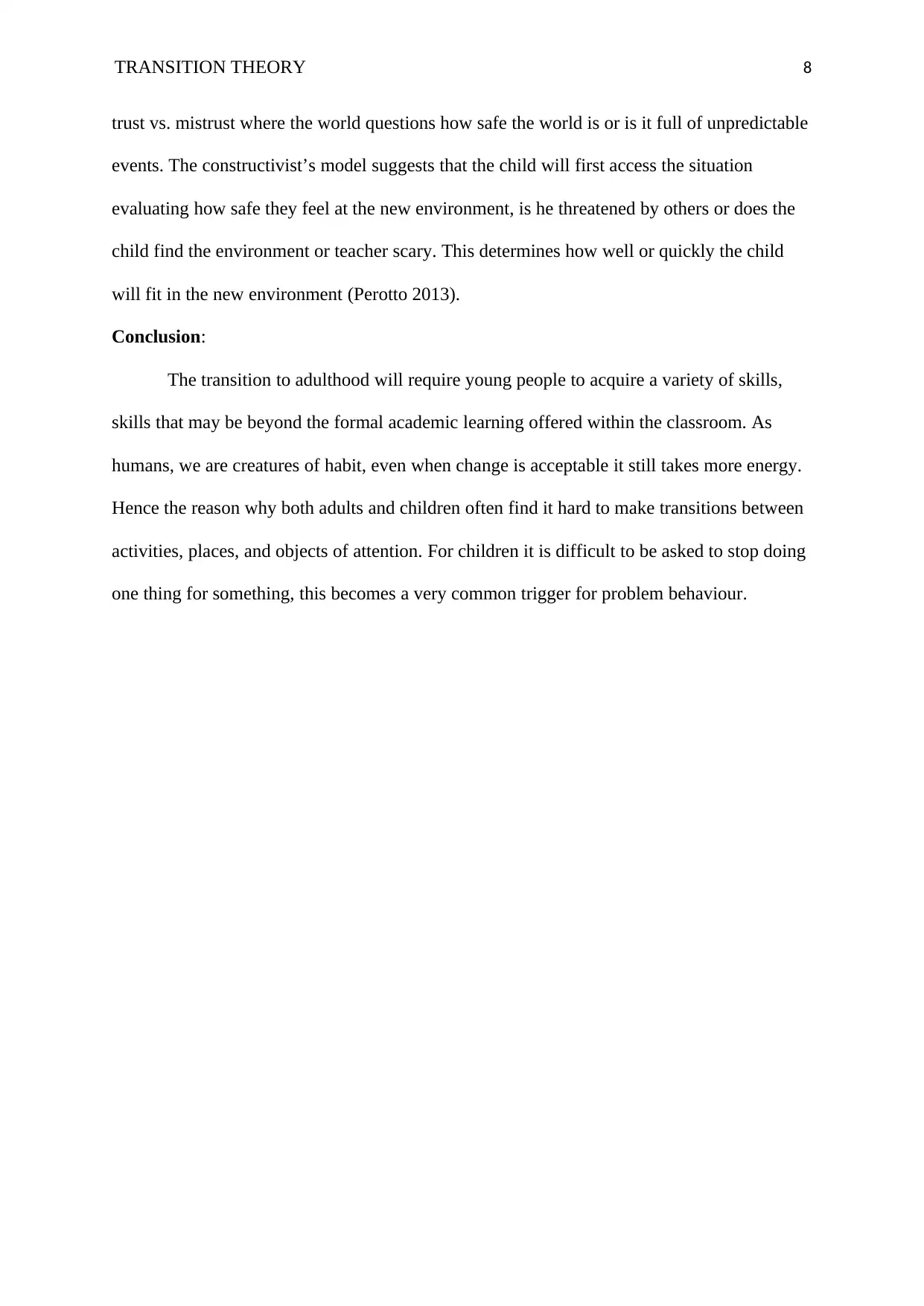
TRANSITION THEORY 8
trust vs. mistrust where the world questions how safe the world is or is it full of unpredictable
events. The constructivist’s model suggests that the child will first access the situation
evaluating how safe they feel at the new environment, is he threatened by others or does the
child find the environment or teacher scary. This determines how well or quickly the child
will fit in the new environment (Perotto 2013).
Conclusion:
The transition to adulthood will require young people to acquire a variety of skills,
skills that may be beyond the formal academic learning offered within the classroom. As
humans, we are creatures of habit, even when change is acceptable it still takes more energy.
Hence the reason why both adults and children often find it hard to make transitions between
activities, places, and objects of attention. For children it is difficult to be asked to stop doing
one thing for something, this becomes a very common trigger for problem behaviour.
trust vs. mistrust where the world questions how safe the world is or is it full of unpredictable
events. The constructivist’s model suggests that the child will first access the situation
evaluating how safe they feel at the new environment, is he threatened by others or does the
child find the environment or teacher scary. This determines how well or quickly the child
will fit in the new environment (Perotto 2013).
Conclusion:
The transition to adulthood will require young people to acquire a variety of skills,
skills that may be beyond the formal academic learning offered within the classroom. As
humans, we are creatures of habit, even when change is acceptable it still takes more energy.
Hence the reason why both adults and children often find it hard to make transitions between
activities, places, and objects of attention. For children it is difficult to be asked to stop doing
one thing for something, this becomes a very common trigger for problem behaviour.
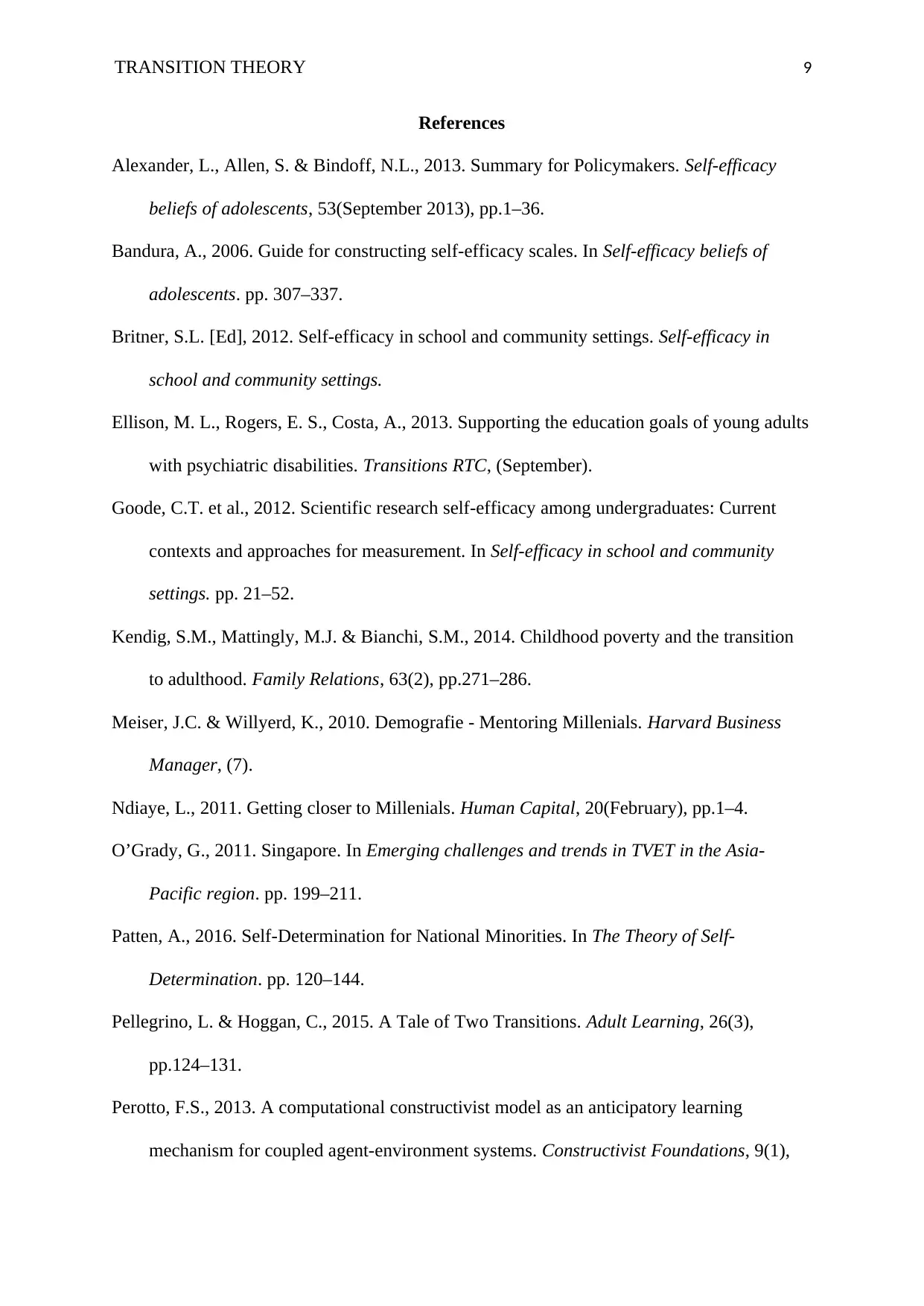
TRANSITION THEORY 9
References
Alexander, L., Allen, S. & Bindoff, N.L., 2013. Summary for Policymakers. Self-efficacy
beliefs of adolescents, 53(September 2013), pp.1–36.
Bandura, A., 2006. Guide for constructing self-efficacy scales. In Self-efficacy beliefs of
adolescents. pp. 307–337.
Britner, S.L. [Ed], 2012. Self-efficacy in school and community settings. Self-efficacy in
school and community settings.
Ellison, M. L., Rogers, E. S., Costa, A., 2013. Supporting the education goals of young adults
with psychiatric disabilities. Transitions RTC, (September).
Goode, C.T. et al., 2012. Scientific research self-efficacy among undergraduates: Current
contexts and approaches for measurement. In Self-efficacy in school and community
settings. pp. 21–52.
Kendig, S.M., Mattingly, M.J. & Bianchi, S.M., 2014. Childhood poverty and the transition
to adulthood. Family Relations, 63(2), pp.271–286.
Meiser, J.C. & Willyerd, K., 2010. Demografie - Mentoring Millenials. Harvard Business
Manager, (7).
Ndiaye, L., 2011. Getting closer to Millenials. Human Capital, 20(February), pp.1–4.
O’Grady, G., 2011. Singapore. In Emerging challenges and trends in TVET in the Asia-
Pacific region. pp. 199–211.
Patten, A., 2016. Self-Determination for National Minorities. In The Theory of Self-
Determination. pp. 120–144.
Pellegrino, L. & Hoggan, C., 2015. A Tale of Two Transitions. Adult Learning, 26(3),
pp.124–131.
Perotto, F.S., 2013. A computational constructivist model as an anticipatory learning
mechanism for coupled agent-environment systems. Constructivist Foundations, 9(1),
References
Alexander, L., Allen, S. & Bindoff, N.L., 2013. Summary for Policymakers. Self-efficacy
beliefs of adolescents, 53(September 2013), pp.1–36.
Bandura, A., 2006. Guide for constructing self-efficacy scales. In Self-efficacy beliefs of
adolescents. pp. 307–337.
Britner, S.L. [Ed], 2012. Self-efficacy in school and community settings. Self-efficacy in
school and community settings.
Ellison, M. L., Rogers, E. S., Costa, A., 2013. Supporting the education goals of young adults
with psychiatric disabilities. Transitions RTC, (September).
Goode, C.T. et al., 2012. Scientific research self-efficacy among undergraduates: Current
contexts and approaches for measurement. In Self-efficacy in school and community
settings. pp. 21–52.
Kendig, S.M., Mattingly, M.J. & Bianchi, S.M., 2014. Childhood poverty and the transition
to adulthood. Family Relations, 63(2), pp.271–286.
Meiser, J.C. & Willyerd, K., 2010. Demografie - Mentoring Millenials. Harvard Business
Manager, (7).
Ndiaye, L., 2011. Getting closer to Millenials. Human Capital, 20(February), pp.1–4.
O’Grady, G., 2011. Singapore. In Emerging challenges and trends in TVET in the Asia-
Pacific region. pp. 199–211.
Patten, A., 2016. Self-Determination for National Minorities. In The Theory of Self-
Determination. pp. 120–144.
Pellegrino, L. & Hoggan, C., 2015. A Tale of Two Transitions. Adult Learning, 26(3),
pp.124–131.
Perotto, F.S., 2013. A computational constructivist model as an anticipatory learning
mechanism for coupled agent-environment systems. Constructivist Foundations, 9(1),
⊘ This is a preview!⊘
Do you want full access?
Subscribe today to unlock all pages.

Trusted by 1+ million students worldwide
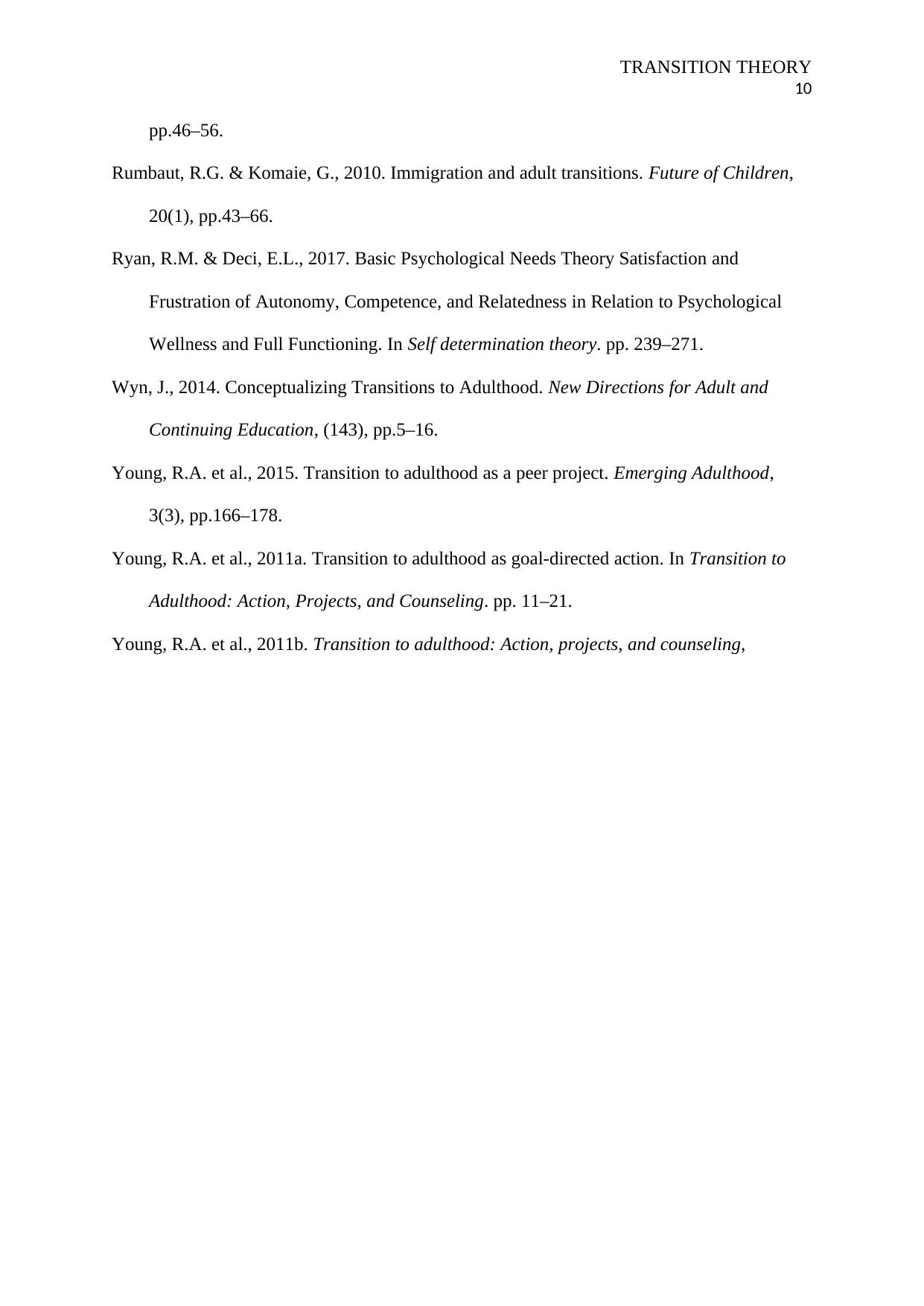
TRANSITION THEORY
10
pp.46–56.
Rumbaut, R.G. & Komaie, G., 2010. Immigration and adult transitions. Future of Children,
20(1), pp.43–66.
Ryan, R.M. & Deci, E.L., 2017. Basic Psychological Needs Theory Satisfaction and
Frustration of Autonomy, Competence, and Relatedness in Relation to Psychological
Wellness and Full Functioning. In Self determination theory. pp. 239–271.
Wyn, J., 2014. Conceptualizing Transitions to Adulthood. New Directions for Adult and
Continuing Education, (143), pp.5–16.
Young, R.A. et al., 2015. Transition to adulthood as a peer project. Emerging Adulthood,
3(3), pp.166–178.
Young, R.A. et al., 2011a. Transition to adulthood as goal-directed action. In Transition to
Adulthood: Action, Projects, and Counseling. pp. 11–21.
Young, R.A. et al., 2011b. Transition to adulthood: Action, projects, and counseling,
10
pp.46–56.
Rumbaut, R.G. & Komaie, G., 2010. Immigration and adult transitions. Future of Children,
20(1), pp.43–66.
Ryan, R.M. & Deci, E.L., 2017. Basic Psychological Needs Theory Satisfaction and
Frustration of Autonomy, Competence, and Relatedness in Relation to Psychological
Wellness and Full Functioning. In Self determination theory. pp. 239–271.
Wyn, J., 2014. Conceptualizing Transitions to Adulthood. New Directions for Adult and
Continuing Education, (143), pp.5–16.
Young, R.A. et al., 2015. Transition to adulthood as a peer project. Emerging Adulthood,
3(3), pp.166–178.
Young, R.A. et al., 2011a. Transition to adulthood as goal-directed action. In Transition to
Adulthood: Action, Projects, and Counseling. pp. 11–21.
Young, R.A. et al., 2011b. Transition to adulthood: Action, projects, and counseling,
1 out of 10
Related Documents
Your All-in-One AI-Powered Toolkit for Academic Success.
+13062052269
info@desklib.com
Available 24*7 on WhatsApp / Email
![[object Object]](/_next/static/media/star-bottom.7253800d.svg)
Unlock your academic potential
Copyright © 2020–2025 A2Z Services. All Rights Reserved. Developed and managed by ZUCOL.




